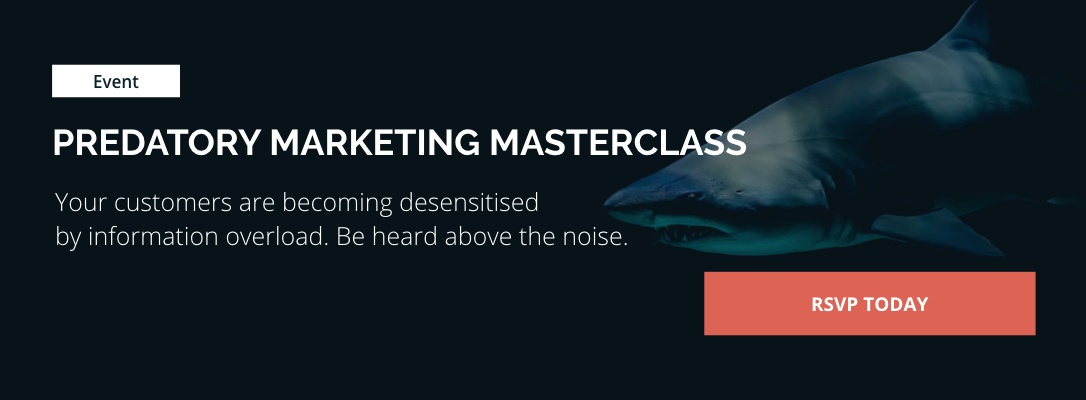All of us want our message heard. All of us want our message to impact our customers’ lives. All of us want to drive sales and boost profit margins.
But the brutal truth is, more than often, our messages are ignored and our perspectives—no matter how valuable—are being missed. Australians are bombarded with thousands of ads and calls-to-actions a day and the fact is: people are becoming desensitised by information overload.
Predatory Marketing is the answer to being heard above the noise. It’s a development that challenges any preconceptions we may hold about how organisations can expand their client base.
The New Marketing Reality
The way marketing is taught has followed a typical pattern for decades now—that it's about meeting the needs of customers. But this is changing.
It's no longer enough to assume that your target audience has needs that require fulfilling. The business world is advanced enough that most of your target audience is likely to be at least satisfied with the goods and services they already have access to. Today, the only predictable need that customers have is a need for less corporate 'noise'—communications that are overwhelming customers with too much information.
The challenge is now for business leaders to stop thinking about simply meeting customer needs and to target the weaknesses of their competition (more on this later). In other words, companies need to embrace Predatory Marketing.
Predator or Prey?
Now that companies can no longer think solely about satisfying needs, they have to start asking, "Who has my money?" It's a zero-sum game that businesses are operating in, and organisations now have to tailor their marketing practices to ensure they accommodate this new reality.
Failing to keep up with these changes will ultimately make it harder for companies to grow, especially as their competitors actively start trying to poach customers from their brand.
Cutting Through the Noise
In Australia, we spend roughly $13.3 billion on marketing per annum—translating into around a million branded messages that each of us see every year. That's 3,000 every single day.
Of those 3,000, we will only notice 80 and react to 10. And of these 10, we instantly treat half as unwelcome intrusions into our lives—leaving only five messages a day we actually notice, react/respond positively to and absorb.
When crafting a message that can qualify as one of that handful, you also have to remember the five-ninths law. This law states that five-ninths of marketing messages will be misattributed to the leader of a market segment, rather than the company paying for the message.
For organisations that aren't in this leadership position, they are essentially cementing the position of their leading competitor with their own marketing budget. Overcoming this gap, and crafting messages that actually move market share away from competitors is therefore key to building a successful Predatory Marketing campaign.
What Predatory Marketing Looks Like
Whenever we work with clients who are looking to embrace Predatory Marketing, there are four key steps we advise them to take:
Step 1. Identify where the money would go if your company didn't exist
Imagine your business didn't exist—where would your customers' money go? A competitor? Or would customers spend it on a completely different offering?
Asking these questions is the foundation of a competitor analysis. From just asking these questions, you'll usually identify four or five competitor organisations that are offering a comparable product that your customers would gravitate towards.
From there, we are looking to narrow down the list to find a target. This means identifying a competitor that is very large or is perhaps a little lazy and isn't meeting the needs of its customers. If you can find one of these, then you have the starting point of your Predatory Marketing campaign.
Step 2. What are the strengths of the opposition?
Now that you have a competitor lined up, you need to objectively evaluate their strengths. To do this, put yourself in the shoes of a customer or consider why a third-party would recommend them.
What you are looking at here is the natural language around what the company's offering, rather than a slogan grounded in marketing jargon. When you can express in simple terms the strengths of your competitor, the next step is much easier: weaknesses.
Step 3. Find the weakness that comes from the opposition’s greatest strength
Within every strength is a hidden weakness. The challenge with Predatory Marketing is to find the specific weakness that arises from a particular strength and then explain it to the customers. The reality is that customers won't necessarily notice this weakness by themselves, nor will they know that you can address this weakness — unless you tell them.
Step 4. Where are you strong?
The final step is to build your strengths to address this pain point and then convey this value to customers. You can be explicit here when communicating with prospective clients—acknowledge the strengths of a competitor before honing in on the weaknesses that your products and services can address.
Many business owners won't have taken this step. They don't to really understand where the value lies in their own product offering and how these match the weaknesses of their competitors.
Tailoring a Predatory Approach to the Market
These four steps represent the core of a Predatory Marketing campaign, but it's also important, to tailor this offering to the specific market conditions that a firm is operating in.
For example, a firm that already occupies the dominant position within its sector usually shouldn’t be applying a Predatory Marketing approach towards its direct competitors. Instead, it's generally smart to be using these same tactics to grow the market and bring customers into their category.
Challengers who aren't in that dominant position will instead be looking for the competitor or class of competitor that is currently occupying that dominant position. In a very fragmented market, or one that is very generic or confused, it may even be that would be competitors are best to band together to shift a certain audience mindset.
Regardless of whether the target of a Predatory Marketing campaign is a single business, a group of businesses or potential customers, the process is relatively consistent.
Lastly, a Predatory Marketing campaign has to change with your business and with the market. Just as context is key to a great strategy, so too is it central to a Predatory Marketing campaign. If a Predatory Marketing campaign is so successful that a company has become the dominant force in their category, for example, the techniques that got them there may no longer be relevant.
It’s Time to Get Predatory
Customers don’t have needs anymore; their needs have been filled. We need to arm ourselves with new tactics that can help us rise above the noise of our competitors and ensure that our message is the one being heard. Predatory marketing is the best tool to disarm your competitors and will ensure your company is in a position of strength and ultimately boost your profits.





![Predatory Marketing: How to Increase Your ROI without Spending Another Cent [with Examples]](https://blog.hellostepchange.com/hubfs/BLOG/Posts/3-Scale/predatory-marketing-step-change.001.jpeg)









